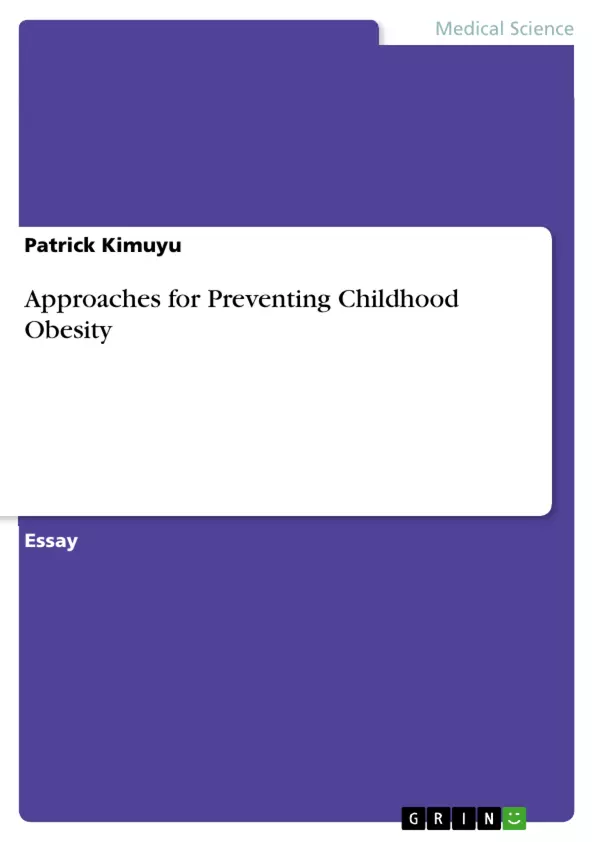Over the past few decades, the burden of non-communicable diseases seems to have been increasing year-by-year. Childhood obesity serves as an outstanding example of non-communicable conditions whose consequences seem to have reached catastrophic levels. Evidence indicates that obesity and overweight trends have been increasing at alarming rates, especially over the past three decades.
This implies that the trends of obesity related health conditions are going to reflect upward changes in the future. According to Parsons, Power, Logan and Summerbell reaffirm that 70% of obese adults became obese during their childhood ages. In retrospect, this phenomenon is believed to be attributable to the greater social inequality in developed countries as compared to developing countries.
Nevertheless, primary prevention strategies are required to reverse the diseases’ trends across the world. Epidemiological rationale for the emphasis on primary prevention of childhood obesity is based on the fact that the condition is difficult to reverse with secondary interventions. Therefore, this report is intended to inform the Federal Health Minister the scope of childhood obesity and the appropriate interventions which can address its impact.
Inhaltsverzeichnis (Table of Contents)
- Introduction
- Epidemiology of Childhood Obesity
- Determinants of Childhood Obesity
- Proposed Approaches for the Prevention of Childhood Obesity
- School-based Childhood Obesity Prevention Approach
- Curriculum Reforms
- Engaging Children in Physical Activity
- Integrating Parents and Teachers
- Community-Based Childhood Obesity Prevention Approach
Zielsetzung und Themenschwerpunkte (Objectives and Key Themes)
This report aims to inform the Federal Health Minister about the scope of childhood obesity and to suggest appropriate interventions to address its impact. It explores the epidemiological trends of childhood obesity, identifies key determinants, and proposes strategies for prevention.
- The increasing prevalence of childhood obesity and its impact on health.
- The role of physical inactivity and unhealthy dietary habits as key determinants of childhood obesity.
- The effectiveness of school-based and community-based interventions in preventing childhood obesity.
- The importance of integrating parents and teachers in school-based programs.
- The need for comprehensive community-based approaches that address food insecurity, modify early life systems, and promote healthy environments.
Zusammenfassung der Kapitel (Chapter Summaries)
- Introduction: This chapter provides an overview of the rising prevalence of childhood obesity and its significance as a non-communicable disease. It highlights the need for primary prevention strategies to address the issue.
- Epidemiology of Childhood Obesity: This chapter presents epidemiological data on childhood obesity from different countries, revealing the global scale of the problem. It suggests that despite differences in prevalence rates, the determinants of childhood obesity are relatively similar across developed and developing countries.
- Determinants of Childhood Obesity: This chapter identifies key factors contributing to childhood obesity, including physical inactivity, excess caloric intake, socio-economic status, socio-cultural factors, and built environment.
- Proposed Approaches for the Prevention of Childhood Obesity: This chapter introduces the concept of primary prevention and emphasizes the need for integrated approaches that combine multiple interventions. It highlights the importance of promoting physical activity and healthy eating habits.
- School-based Childhood Obesity Prevention Approach: This chapter explores the effectiveness of school-based interventions in addressing childhood obesity. It emphasizes the importance of curriculum reforms, engaging children in physical activity, and the role of parents and teachers in promoting healthy habits.
Schlüsselwörter (Keywords)
Childhood obesity, non-communicable diseases, primary prevention, physical activity, healthy eating habits, school-based interventions, community-based interventions, socio-economic status, built environment, epidemiological trends, obesity epidemic.
- Arbeit zitieren
- Patrick Kimuyu (Autor:in), 2018, Approaches for Preventing Childhood Obesity, München, GRIN Verlag, https://www.hausarbeiten.de/document/411951


